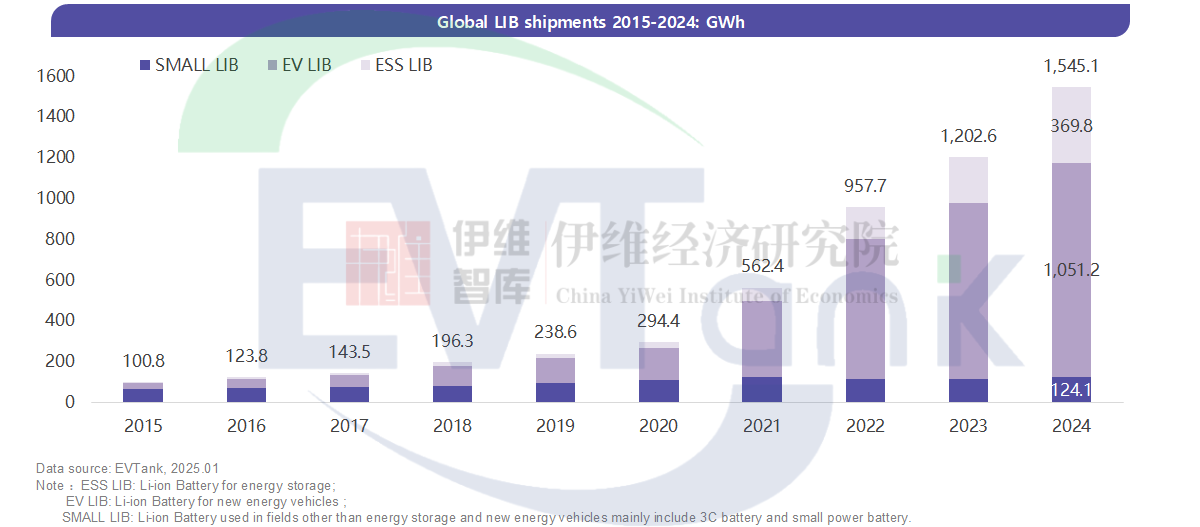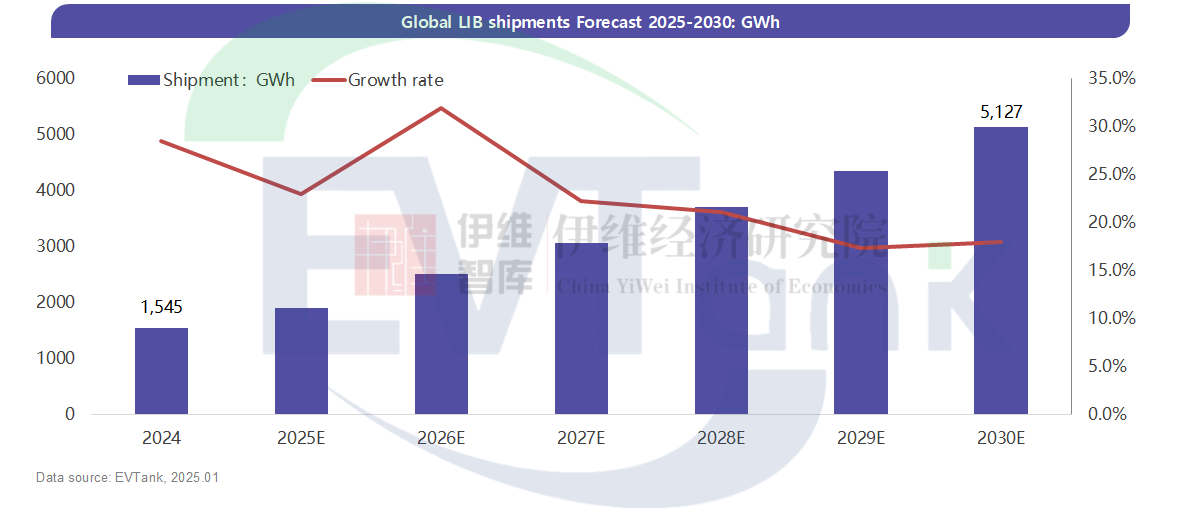Recently, research institution EVTank and China YiWei Institute of Economic jointly released the “White Paper on the Development of China's Li-ion Battery (LIB) Industry (2025)”According to the white paper's data, global lithium-ion battery shipments totaled 1,545.1 GWh in 2024, representing a YOY increase of 28.5%.
From the shipment structure perspective, the impact of China's trade-in policy in 2024 far exceeded expectations. However, unfavorable factors such as economic weakness and interest rate hikes and inflation led to negative growth in the European and American EV markets and single-digit growth in the Chinese market. China continued to be the largest driving force behind global growth. As a result, global EV LIB shipments reached 1,051.2 GWh, representing a YOY increase of 21.5%.
In the ESS sector, China's strong new energy policy in 2024, increased investment by state-owned enterprises, and continuously declining energy storage costs will drive ESS to maintain rapid growth. In the United States, the combination of rigid demand for energy storage and ITC subsidies will have a significant effect. In addition, emerging markets will experience multiple outbreaks of growth. In the second half of 2024, the United Kingdom, Saudi Arabia, Australia, and other countries will sign multiple GWh orders, and global ESS LIB shipments will reach 369.8 GWh, representing a YOY increase of 64.9%.
In the SMALL LIB sector, cyclical trends are evident. Driven by the new round of replacement demand in the ICT sector and technological innovations, the completion of inventory reduction in the small power sector and accelerated electrification will drive the market to stabilize and rebound in 2024. Global shipments of SMALL LIB are projected to reach 124.1 GWh, representing a YOY increase of 9.6%.

For the Chinese market, EVTank data shows that in 2024, China's LIB shipments reached 1,214.6 GWh, a YOY increase of 36.9%, which is 2.6 percentage points higher than the growth rate in 2023. China's share of global LIB shipments reached 78.6%, and its share of shipments continued to increase.EVTank believes that in addition to sustained high demand in the Chinese market, leading companies accelerating their overseas expansion has also led to significant growth in shipments.

Looking ahead, EVTank predicts in its “White Paper on the Development of China's Li-ion Battery (LIB) Industry (2025)” that global LIB shipments will reach 1,899.3 GWh and 5,127.3 GWh in 2025 and 2030, respectively.
In the “White Paper on the Development of China's Li-ion Battery (LIB) Industry (2025),” EVTank conducted detailed research and analysis on the shipment volume and market size of different types of LIB in China and around the world, LIB technology and cost roadmaps, LIB price and cost trends, the regional and corporate competitive landscape of LIB, the current status and trends in the development of LIB materials, including cathodes, anodes, separators, and electrolytes, as well as the shipment volume, technology, cost, and competitive landscape of different types of LIB in 2030.
1.White Paper Framework:
Chapter 1 Basic Attributes of the LIB Industry
I. Definitions and Classification
(1) Definition of LIB
(2) Classification of LIB
II. Research on the LIB Industry Chain
(1) Industry Chain Structure Chart
(2) Upstream Raw Materials Industry
(3) Downstream Application Fields
Chapter 2 Analysis of Policies Related to the LIB Industry
I. Relevant Chinese Policies
(1) Fiscal and Tax Policies
(2) Industry Regulations
(3) Import and Export Policies
II. Relevant Overseas Policies
(1) Inflation Reduction Act (IRA) and Interpretation
(2) EU New Battery Regulation and Interpretation
(3) Import and Export Policies
III. Analysis of International Geopolitical Impact
(1) Analysis of the Impact Following the Trump Administration's Assumption of Office
(2) Analysis of the Geopolitical Impact Between China and the United States
(3) Analysis of the Geopolitical Impact Between China and the European Union
(4) Other
Chapter 3 Research on the Development Status of the LIB Industry in 2024
I. Analysis of Global Shipments from 2019 to 2024
(1) Analysis of Overall Shipments
(2) Analysis of Shipments by Category (Small, Power, and ESS)
(3) Analysis of Shipments by Material System (LFP, NCM, and Others)
(4) Analysis of Shipments by Shape (Cy, Pr, and Po)
II. Analysis of Chinese Shipments from 2019 to 2024
(1) Overall Shipment Analysis
(2) Analysis of Shipments by Category (Small, Power, and ESS)
(3) Analysis of Shipments by Material System (LFP, NCM, and Others)
(4) Analysis of Shipments by Shape (Cy, Pr, and Po)
III. Analysis of the LIB Market Size from 2019 to 2024
(1) Global market size
(2) Chinese market size
IV. Analysis of the current production capacity of the LIB industry in 2024
(1) Research on the production capacity of major global companies
(2) Research on the production capacity of major Chinese companies
V. Analysis of the development path of LIB technology
(1) Technology roadmap
(2) Cost roadmap
(3) Next-generation battery technology
(4) Profitability analysis
VI. Analysis of LIB costs and prices
(1) Price trend analysis
(2) Cost trend analysis
(3) Profitability analysis
VII. Analysis of the development characteristics of the LIB industry in 2024
Chapter 4 Analysis of the LIB Industry in Major Countries and Regions in 2024
I. Europe
(1) Analysis of LIB Shipments
(2) Analysis of Key LIB Companies and Production Capacity Layout
(3) Analysis of Key Battery Material Companies and Production Capacity Layout
II. United States
(1) Analysis of LIB Shipments
(2) Analysis of Key LIB Companies and Production Capacity Layout
(3) Analysis of key battery material companies and production capacity layout
III. Japan and South Korea
(1) Analysis of LIB shipments
(2) Analysis of key LIB companies and production capacity layout
(3) Analysis of key battery material companies and production capacity layout
IV. Southeast Asia
(1) Analysis of LIB shipments
(2) Analysis of key LIB companies and production capacity layout
(3) Analysis of key battery material companies and production capacity layout
Chapter 5 Analysis of the competitive landscape of LIB in 2024
I. Regional competitive landscape
(1) Share of LIB shipments in different countries and regions
(2) Share of LIB shipments in different regions of China
II. Corporate competitive landscape
(1) Competitive landscape of EV LIB companies
(2) Competitive landscape of ESS LIB companies
(3) Competitive landscape of SMALL LIB companies
III. Technology Roadmap Competitive Landscape
(1) Battery shipment structure of different material systems
(2) Battery shipment structure of different shapes
IV. New Features of the LIB Enterprise Competitive Landscape
V. LIB Industry Chain Enterprise Directory
Chapter 6 Analysis of the Four Major Materials Used in LIBs in China
I. Cathode Materials
(1) Shipment Volume and Market Size
(2) Competitive Landscape of Major Companies
(3) Industry Characteristics and Trends
II. Anode Materials
(1) Shipment Volume and Market Size
(2) Competitive Landscape of Major Companies
(3) Industry Characteristics and Trends
III. Separator Materials
(1) Shipment Volume and Market Size
(2) Competitive Landscape of Major Companies
(3) Industry Development Characteristics and Trends
IV. Electrolyte Materials
(1) Shipment Volume and Market Size
(2) Competitive Landscape of Major Companies
(3) Industry Development Characteristics and Trends
Chapter 7 Analysis of LIB Industry Development Trends from 2025 to 2030
I. Analysis of Small LIB Development Trends from 2025 to 2030
(1) Shipment Forecast
(2) Technology Development Trends
(3) Analysis of Major New Application Market Development Trends
II. Analysis of EV LIB Development Trends from 2025 to 2030
(1) Shipment Volume Forecast
(2) Technological Development Trends
(3) Analysis of Key New Application Market Development Trends
III. Analysis of the Development Trends of ESS LIB from 2025 to 2030
(1) Shipment Volume Forecast
(2) Technological Development Trends
(3) Analysis of Key New Application Market Development Trends
IV. Forecast of the supply-demand relationship between ESS LIB and EV LIB
(1) Research on production capacity and planned production capacity
(2) Overall demand forecast
(3) Supply-demand relationship forecast
V. Analysis of the impact of other battery technologies on the development of LIB
(1) Sodium-ion battery technology
(2) Fuel cell technology
(3) Flow battery technology
(4) Other battery technologies
2. Introduction to the joint publishers of the white paper
EVTank: A leading global third-party institution specializing in research on electric vehicles and related industries, providing independent and authoritative professional research services to all stakeholders, manufacturers, purchasers, suppliers, investors, banks, and governments. www.evtank.cn
Yiwei Economic Research Institute: A third-party think tank established in accordance with the law under the support of the national competent authorities, specializing in research and consulting in the field of emerging industries. The institute has established specialized research centers such as the Automotive Industry Research Center, the Energy Conservation and Environmental Protection Industry Research Center, the Electronics and Information Industry Research Center, the Intelligent Manufacturing Industry Research Center, and the New Energy and New Materials Industry Research Center. The institute primarily serves governments, enterprises, and financial institutions, offering professional services such as industrial planning, investment promotion services, market research, industry analysis, enterprise management consulting, investment and financing consulting, and feasibility studies. The institute's headquarters is located in Beijing, with branches in Shanghai, Shenzhen, Chongqing, and other regions. www.yiweiresearch.com
China Battery Industry Research Institute: An independent research institution headquartered in Beijing, specializing in research and consulting services for the new energy battery industry chain, as well as big data research and development. The institute is committed to providing clients with authoritative, independent, and professional third-party industry research reports and data.
【Email:EVTank@163.com;service@evtank.cn】
【Tel:18513957599,same number on WeChat】